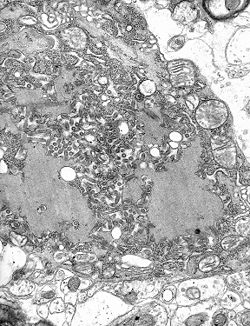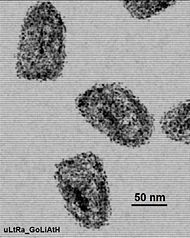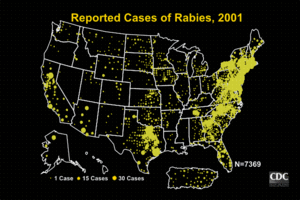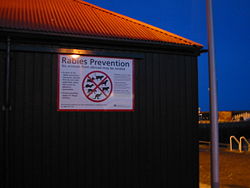Rabies
2008/9 Schools Wikipedia Selection. Related subjects: Health and medicine
| Rabies virus | ||||||||
|---|---|---|---|---|---|---|---|---|
| Virus classification | ||||||||
|
||||||||
| Type species | ||||||||
| Rabies virus |
| Rabies Classification and external resources |
|
| EM of rabies virus. | |
| ICD- 10 | A 82.- |
| ICD- 9 | 071 |
| DiseasesDB | 11148 |
| MedlinePlus | 001334 |
| eMedicine | med/1374 emerg/493 ped/1974 |
| MeSH | D011818 |
Rabies (from Latin: rabies, “madness, rage, fury.” Also known as “hydrophobia”) is a viral zoonotic neuroinvasive disease that causes acute encephalitis (inflammation of the brain) in mammals.
In non-vaccinated humans, rabies is almost invariably fatal after neurological symptoms have developed, but prompt post-exposure vaccination may prevent the virus from progressing. There are only six known cases of a person surviving symptomatic rabies, and only one known case of survival in which the patient received no rabies-specific treatment either before or after illness onset.
Structure
The virus is a Lyssavirus. This genus of RNA viruses also includes the Aravan virus, Australian bat lyssavirus, Duvenhage virus, European bat lyssavirus 1, European bat lyssavirus 2, Irkut virus, Khujand virus, Lagos bat virus, Mokola virus and West Caucasian bat virus. Lyssaviruses have helical symmetry, so their infectious particles are approximately cylindrical in shape. This is typical of plant-infecting viruses; human-infecting viruses more commonly have cubic symmetry and take shapes approximating regular polyhedra. Negri bodies in the infected neurons are pathognomonic.
The virus has a bullet-like shape with a length of about 180 nm and a cross-sectional diameter of about 75 nm. One end is rounded or conical and the other end is planar or concave. The lipoprotein envelope carries knob-like spikes composed of Glycoprotein G. Spikes do not cover the planar end of the virion (virus particle). Beneath the envelope is the membrane or matrix (M) protein layer which may be invaginated at the planar end. The core of the virion consists of helically arranged ribonucleoprotein. The genome is unsegmented linear antisense RNA. Also present in the nucleocapsid are RNA dependent RNA transcriptase and some structural proteins.
Differential diagnosis
The differential diagnosis in a case of suspected human rabies may initially include any cause of encephalitis, particularly infection with viruses such as herpesviruses, enteroviruses, and arboviruses (e.g., West Nile virus). The most important viruses to rule out are herpes simplex virus type 1, varicella-zoster virus, and (less commonly) enteroviruses, including coxsackieviruses, echoviruses, polioviruses, and human enteroviruses 68 to 71. A specific diagnosis may be made by a variety of diagnostic techniques, including polymerase chain reaction (PCR) testing of cerebrospinal fluid, viral culture, and serology. In addition, consideration should be given to the local epidemiology of encephalitis caused by arboviruses belonging to several taxonomic groups, including eastern and western equine encephalitis viruses, St. Louis encephalitis virus, Powassan virus, the California encephalitis virus serogroup, and La Crosse virus.
New causes of viral encephalitis are also possible, as was evidenced by the recent outbreak in Malaysia of some 300 cases of encephalitis (mortality rate, 40%) caused by Nipah virus, a newly recognized paramyxovirus. Similarly, well-known viruses may be introduced into new locations, as is illustrated by the recent outbreak of encephalitis due to West Nile virus in the eastern United States. Epidemiologic factors (e.g., season, geographic location, and the patient’s age, travel history, and possible exposure to animal bites, rodents, and ticks) may help direct the diagnostic workup.
Cheaper rabies diagnosis will be possible for low-income settings according to research reported on the Science and Development Network website in 2008. Accurate rabies diagnosis can be done ten times cheaper, according to researchers from the Farcha Veterinary and Livestock Research Laboratory and the Support International Health Centre in N'Djamena, Chad. The scientists evaluated a method using light microscopy, cheaper than the standard tests, and say this could provide better rabies control across Africa.
Transmission and symptoms

Any mammal may become infected with the rabies virus and develop symptoms, including humans. Most animals can be infected by the virus and can transmit the disease to humans. Infected bats, monkeys, raccoons, foxes, skunks, cattle, wolves, dogs or cats provide the greatest risk to humans. Rabies may also spread through exposure to infected domestic farm animals, groundhogs, weasels and other wild carnivores. Rodents (mice, squirrels etc) are seldom infected.
The virus is usually present in the nerves and saliva of a symptomatic rabid animal. The route of infection is usually, but not necessarily, by a bite. In many cases the infected animal is exceptionally aggressive, may attack without provocation, and exhibits otherwise uncharacteristic behaviour . Transmission may also occur via an aerosol through mucous membranes; transmission in this form may have happened in people exploring caves populated by rabid bats.
Transmission between humans is extremely rare, although it can happen through transplant surgery (see below for recent cases), or, even more rarely, through bites, kisses or sexual relations.
After a typical human infection by bite, the virus enters the peripheral nervous system. It then travels along the nerves towards the central nervous system. During this phase, the virus cannot be easily detected within the host, and vaccination may still confer cell-mediated immunity to prevent symptomatic rabies. Once the virus reaches the brain, it rapidly causes encephalitis. This is called the “prodromal” phase. At this time, treatment is useless. Then symptoms appear. Rabies may also inflame the spinal cord producing myelitis.
The period between infection and the first flu-like symptoms is normally two to twelve weeks, but can be as long as two years. Soon after, the symptoms expand to slight or partial paralysis, cerebral dysfunction, anxiety, insomnia, confusion, agitation, abnormal behaviour, paranoia, terror, hallucinations, progressing to delirium. The production of large quantities of saliva and tears coupled with an inability to speak or swallow are typical during the later stages of the disease; this can result in “ hydrophobia,” where the victim has difficulty swallowing because the throat and jaw become slowly paralyzed, shows panic when presented with liquids to drink, and cannot quench his or her thirst. The disease itself was also once commonly known as hydrophobia, from this characteristic symptom. The patient “foams at the mouth” because they cannot swallow their own saliva for days and it gathers in the mouth until it overflows.
Death almost invariably results two to ten days after the first symptoms; the few humans who are known to have survived the diseasewere all left with severe brain damage, with the recent exception of Jeanna Giese (see below). It is neurotropic in nature.
Example of symptoms
In Rabies: The Facts, Kaplan et. al. describe several typical cases, including one of a 23 year-old Englishwoman:
“On June 17, 1981 she was bitten on the ankle by a dog in New Delhi. On August 18, about two months later, she experienced the first prodromal symptoms. She became anxious and depressed, and it became impossible for her to drink more than small sips of liquid. While sleeping, she frequently sat up in bed suddenly, terrified. On August 19, she became confused, hallucinated, and was incontinent of urine. On August 20, she was unable to eat or drink and was taken to the hospital where she hallucinated and screamed in terror. Misdiagnosed as a psychiatric case, she was injected with a tranquilizer and sent home, however she repeatedly woke up screaming in fear and became so wild and agitated that her husband felt he could not deal with her by himself and took her to her mother's house. She remained terrified, hallucinating and screaming in horror throughout the night. She had no water for almost three days. She fell into a coma the next morning, and died on August 23.”
Prevention
Rabies can be prevented by vaccination, both in humans and other animals. Virtually every infection with rabies resulted in death, until Louis Pasteur and Emile Roux developed the first rabies vaccination in 1885. This vaccine was first used on a human on July 6, 1885 – nine-year old boy Joseph Meister (1876–1940) had been mauled by a rabid dog.
Their vaccine consisted of a sample of the virus harvested from infected (and necessarily dead) rabbits, which was weakened by allowing it to dry for 5 to 10 days. Similar nerve tissue-derived vaccines are still used now in some countries, and while they are much cheaper than modern cell culture vaccines, they are not as effective and carry a certain risk of neurological complications.
The human diploid cell rabies vaccine (H.D.C.V.) was started in 1967. Human diploid cell rabies vaccines are made using the attenuated Pitman-Moore L503 strain of the virus. Human diploid cell rabies vaccines have been given to more than 1.5 million humans as of 2006. Newer and less expensive purified chicken embryo cell vaccine, and purified Vero cell rabies vaccine are now available. The purified Vero cell rabies vaccine uses the attenuated Wistar strain of the rabies virus, and uses the Vero cell line as its host.
Some recent works have shown that during lethal rabies infection the blood-brain barrier (BBB) does not allow anti-viral immune cells to enter the brain, the primary site of rabies virus replication. This aspect contributes to the pathogenicity of the virus and artificially increasing BBB permeability promotes viral clearance. Opening the BBB during rabies infection has been suggested as a possible novel approach to treat the disease.
Post-exposure prophylaxis
Treatment after exposure, known as post-exposure prophylaxis or “P.E.P.”, is highly successful preventing the disease if administered promptly, within six days after infection and consists of over a 28 day period. Thoroughly washing the wound as soon as possible with soap and water for approximately five minutes is very effective at reducing the number of viral particles. “If available, a virucidal antiseptic such as povidone-iodine, iodine tincture, aqueous iodine solution or alcohol (ethanol) should be applied after washing.” Exposed mucous membranes such as eyes, nose or mouth should be flushed well with water. In the United States, patients receive one dose of immunoglobulin and five doses of rabies vaccine over a twenty-eight day period. One-half the dose of immunoglobulin is injected in the region of the bite, if possible, with the remainder injected intramuscularly away from the bite. This is much less painful compared with administering immunoglobulin through the abdominal wall with a large needle, as was done in the past. The first dose of rabies vaccine is given as soon as possible after exposure, with additional doses on days three, seven, fourteen, and twenty-eight after the first. Patients that have previously received pre-exposure vaccination do not receive the immunoglobulin, only the post-exposure vaccinations on day 0 and 3. Since the widespread vaccination of domestic dogs and cats and the development of effective human vaccines and immunoglobulin treatments, the number of recorded deaths in the U.S. from rabies has dropped from one hundred or more annually in the early twentieth century, to 1–2 per year, mostly caused by bat bites, which may go unnoticed by the victim and hence untreated.
P.E.P. is effective in treating rabies because the virus must travel from the site of infection through the peripheral nervous system (nerves in the body) before infecting the central nervous system (brain and spinal cord) and glands to cause lethal damage. This travel along the nerves is usually slow enough that vaccine and immunoglobulin can be administered to protect the brain and glands from infection. The amount of time this travel requires is dependent on how far the infected area is from the brain: if the victim is bitten in the face, for example, the time between initial infection and infection of the brain is very short and P.E.P. may not be successful.
Pre-exposure prophylaxis
Currently pre-exposure immunization has been used on domesticated and normal non-human populations. In many jurisdictions, domestic dogs, cats, and ferrets are required to be vaccinated. A pre-exposure vaccination is also available for humans, most commonly given to veterinarians and those traveling to regions where the disease is common, such as India. Most tourists do not need such a vaccination, just those doing substantial non-urban activities. However, should a vaccinated human be bitten by a carrier, failure to receive subsequent post-exposure treatment could be fatal, although post-exposure treatment for a vaccinated human is far less extensive than that which would normally be required by one with no pre-exposure vaccination.
In 1984 researchers at the Wistar Institute developed a recombinant vaccine called V-RG by inserting the glycoprotein gene from rabies into a vaccinia virus. The V-RG vaccine has since been commercialised by Merial under the trademark Raboral. It is harmless to humans and has been shown to be safe for various species of animals that might accidentally encounter it in the wild, including birds (gulls, hawks, and owls).
V-RG has been successfully used in the field in Belgium, France, and the United States to prevent outbreaks of rabies in wildlife. The virus is stable under relatively high temperatures and can be delivered orally, making mass vaccination of wildlife possible by putting it in tasty baits. The plan for immunization of normal populations involves dropping bait containing food wrapped around a small dose of the live virus. The bait would be dropped by helicopter concentrating on areas that have not been infected yet. Just such a strategy of oral immunization of foxes in Europe has already achieved substantial reductions in the incidence of human rabies. A strategy of vaccinating “neighbourhood dogs” in Jaipur, India, (combined with a sterilization program) has also resulted in a large reduction in the number of human cases.
Induced coma treatment
In 2005, the case of Jeanna Giese, a girl of 15 who survived acute, unvaccinated rabies was reported, indicating the successful treatment of rabies through induction of a coma. This treatment approach was based on the theory that rabies' detrimental effects were caused by temporary dysfunctions of the brain, and that the induction of a coma, by producing a temporary partial stop in brain function, would protect the brain from damage while the body built up an immune response to the virus. After thirty-one days of isolation and seventy-six days of hospitalisation, she was released from the hospital, having survived rabies.
Rodney Willoughby Jr., the primary care physician in this case published in the April 2007 issue of Scientific American. He notes that subsequent failures of what he calls the Milwaukee protocol did not use the cocktail of drugs used during the treatment. A point he makes for future research is the relationship of the virus to depletion of biopterin in the brain.
Later attempts to use the same treatment have failed, but in April, 2008, in Cali, Colombia, it was reported (by local newspapers) that an 11-year-old may have recovered successfully after induction of coma . This patient was infected on February 15 when several children were bitten by a cat in Santander de Quilichao, a small town near Cali. However, this claim has not been scientifically proven.
Prevalence

Australia, New Zealand, Singapore, Fiji, Guam, Hawaii, the United Kingdom, Republic of Ireland, Norway, Sweden, Finland, Iceland, Japan and Taiwan/ROC.
There are an estimated 55,000 human deaths annually from rabies worldwide, with about 31,000 in Asia, and 24,000 in Africa.
One of the sources of recent flourishing of rabies in East Asia is the pet boom. China introduced in the city of Beijing the “ One Dog policy” in November 2006 to control the problem. India has been reported as having the highest rate of human rabies in the world .
The English Channel, dog licensing, killing of stray dogs, muzzling and other measures contributed to the elimination of rabies from the United Kingdom in the early 20th century. More recently, large-scale vaccination of cats, dogs and ferrets has been successful in combatting rabies in some developed countries.
The rabies virus survives in wide-spread, varied, rural fauna reservoirs. However, in Asia, parts of America and large parts of Africa, dogs remain the principal host. Mandatory vaccination of animals is less effective in rural areas. Especially in developing countries, pets may not be privately kept and their destruction may be unacceptable. Oral vaccines can be safely distributed in baits, and this has successfully reduced rabies in rural areas of France, Ontario, Texas, Florida and elsewhere, like in the City of Montréal (Québec) where baits are successfully used among raccoons in the Mont-Royal park area. Vaccination campaigns may be expensive, and a cost-benefit analysis can lead those responsible to opt for policies of containment rather than elimination of the disease.
Many territories, such as the United Kingdom, Ireland, Taiwan, Japan, Hawaii, Mauritius, Barbados and Guam, are free of rabies, although there may be a very low prevalence of rabies among bats in the UK; see below.
New Zealand and Australia have never had rabies. However, in Australia, the Australian Bat Lyssavirus occurs normally in both insectivorous and fruit eating bats (flying foxes) from most mainland states. Scientists believe it is present in bat populations throughout the range of flying foxes in Australia.
The UK is not completely free of rabies, as a new form of the lyssavirus has been found in some bats which could possibly affect humans. There has been one case of a bite from an infected bat, but the victim showed no symptoms of the virus and was vaccinated quickly as a precaution.
Rabies in the United States
Rabies was once rare in the United States outside the Southern states, but raccoons in the mid-Atlantic and northeast United States have been suffering from a rabies epidemic since the 1970s, which is now moving westwards into Ohio.
The particular variant of the virus has been identified in the southeastern United States raccoon population since the 1950s, and is believed to have traveled to the northeast as the result of infected raccoons being among those caught and transported from the southeast to the northeast by human hunters attempting to replenish the declining northeast raccoon population. As a result, urban residents of these areas have become more wary of the large but normally unseen urban raccoon population. It has become the common assumption that any raccoon seen diurnally is infected; certainly the reported behaviour of most such animals appears to show some sort of illness, and necropsies can confirm rabies. Whether as a result of increased vigilance or only the common human avoidance reaction to any other animal not normally seen, such as a raccoon, there has only been one documented human rabies case as a result of this variant. This does not include, however, the greatly increasing rate of prophylactic rabies treatments in cases of possible exposure, which numbered fewer than one hundred humans annually in the state of New York before 1990, for instance, but rose to approximately ten thousand annually between 1990 and 1995. At approximately $1,500 per course of treatment, this represents a considerable public health expenditure. Raccoons do constitute approximately 50% of the approximately eight thousand documented non-human rabies cases in the United States. Domestic animals constitute only 8% of rabies cases, but are increasing at a rapid rate.
In the midwestern United States, skunks are the primary carriers of rabies, composing 134 of the 237 documented non-human cases in 1996. The most widely distributed reservoir of rabies in the United States, however, and the source of most human cases in the U.S., are bats. Nineteen of the twenty-two human rabies cases documented in the United States between 1980 and 1997 have been identified genetically as bat rabies. In many cases, victims are not even aware of having been bitten by a bat, assuming that a small puncture wound found after the fact was the bite of an insect or spider; in some cases, no wound at all can be found, leading to the hypothesis that in some cases the virus can be contracted via inhaling airborne aerosols from the vicinity of bats. For instance, the Centers for Disease Control and Prevention warned on May 9, 1997, that a woman who died in October, 1996 in Cumberland County, Kentucky and a man who died in December, 1996 in Missoula County, Montana were both infected with a rabies strain found in silver-haired bats; although bats were found living in the chimney of the woman's home and near the man's place of employment, neither victim could remember having had any contact with them. Similar reports among spelunkers led to experimental demonstration in animals. This inability to recognize a potential infection, in contrast to a bite from a dog or raccoon, leads to a lack of proper prophylactic treatment, and is the cause of the high mortality rate for bat bites.
On September 7, 2007, rabies expert Dr. Charles Rupprecht of Atlanta-based U.S. Centers for Disease Control and Prevention said that canine rabies had disappeared from the United States. Rupprecht emphasized that the disappearance of the canine-specific strain of rabies virus in the US does not eliminate the need for dog rabies vaccination as dogs can still become infected from exposure to wildlife.
Recently publicized cases
Transmission by bite
Several recently publicized cases have stemmed from bats, which are known to be a vector for rabies. See the Rabies and bats section below.
In October 2004 a female brown bear killed one human and injured several others near the city of Braşov in Central Romania. The bear was killed by human hunters and diagnosed with rabies. More than one hundred humans were vaccinated afterwards.
Transmission through organ transplants
Rabies is known to have been transmitted between humans by transplant surgery.
Infections by corneal transplant have been reported in Thailand (2 cases), India (2 cases), Iran (2 cases), the United States (1 case), and France (1 case). Details of two further cases of infection resulting from corneal transplants were described in 1996.
In June 2004, three organ recipients died in the United States from rabies transmitted in the transplanted kidneys and liver of an infected donor from Texarkana. There were bats near the donor's home, and the donor had told others that he had been bitten. The donor is now reported to have died of a cerebral hemorrhage, the culmination of an unidentified neurological disorder, although recipients are said to have been told the cause of death had been a car crash. Marijuana and cocaine were found in the donor's urine at the time of his death, according to a report in The New England Journal of Medicine.
“[The surgeons] thought he had suffered a fatal crack-cocaine overdose, which can produce symptoms similar to those of rabies. ‘We had an explanation for his condition,’ says Dr. Goran Klintmalm, a surgeon who oversees transplantation at Baylor University Medical Centre, where the transplants occurred. ‘He’d recently smoked crack cocaine. He’d hemorrhaged around the brain. He’d died. That was all we needed to know.’ Because of doctor-patient confidentiality rules, doctors involved with this case would not talk about it on the record, but a few did say that if no cocaine was found in the donor’s blood, the E.R. doctors might have investigated his symptoms more aggressively instead of assuming he had overdosed. (Because no autopsy was done, doctors have not been able to establish whether the rabies or the drugs actually killed him.)”
In February 2005, three German patients in Mainz and Heidelberg were diagnosed with rabies after receiving various organs and cornea transplants from a female donor. Two of the infected people died. Three other patients who received organs from the woman have not yet shown rabies symptoms. The 26 year old donor had died of heart failure in December 2004 after consuming cocaine and ecstasy. In October 2004, she had visited India, one of the countries worst affected by rabies worldwide. Dozens of medical staff were vaccinated against rabies in the two hospitals as a precautionary measure. Associated Press reports that “Donated organs are never tested for rabies. The strain detected in the victims’ bodies is one commonly found in bats, health officials said.” According to CNN “Rabies tests are not routine donor screening tests, Virginia McBride, public health organ donation specialist with the Health Resources and Services Administration, said. The number of tests is limited because doctors have only about six hours from the time a patient is declared brain-dead until the transplantation must begin for the organs to maintain viability.”
Transport of pet animals between countries
Rabies is endemic to many parts of the world, and one of the reasons given for quarantine periods in international animal transport has been to try to keep the disease out of uninfected regions. However, most developed countries, pioneered by Sweden, now allow unencumbered travel between their territories for pet animals that have demonstrated an adequate immune response to rabies vaccination.
Such countries may limit movement to animals from countries where rabies is considered to be under control in pet animals. There are various lists of such countries. The United Kingdom has developed a list, and France has a rather different list, said to be based on a list of the Office International des Epizooties (OIE). The European Union has a harmonised list. No list of rabies-free countries is readily available from OIE.
However, the recent spread of rabies in the northeastern United States and further may cause a restrengthening of precautions against movement of possibly rabid animals between countries.
Rabies and dogs
Rabies has a long history of association with dogs. The first written record of rabies is in the Codex of Eshnunna (ca. 1930 BC), which dictates that the owner of a dog showing symptoms of rabies should take preventative measure against bites. If a person is bitten by a rabid dog and later died, the owner was fined heavily.
Three stages of rabies are recognized in dogs. The first stage is a one to three day period characterized by behavioural changes and is known as the prodromal stage. The second stage is the excitative stage, which lasts three to four days. It is this stage that is often known as furious rabies due to the tendency of the affected dog to be hyperreactive to external stimuli and bite at anything near. The third stage is the paralytic stage and is caused by damage to motor neurons. Incoordination is seen due to rear limb paralysis and drooling and difficulty swallowing is caused by paralysis of facial and throat muscles. Death is usually caused by respiratory arrest.
On April 25, 2008 three people were bitten by a rabid puppy which was in quarantine after arriving into the UK on 18 April 2008 from Sri Lanka. The incident happened in the Chingford area of Essex at a licensed quarantine centre and the people involved received vaccinations.
Rabies and opossums
Experimental studies of rabies infection in the Virginia opossum have shown the importance of the mode of transmission. Opossums became infected when exposed to air-borne virus but were found to be fairly resistant to intramuscular inoculations. The aerosol transmission of rabies in opossum was investigated following the death from rabies of two men who had visited the Frio Caves, Texas, and did not remember any direct contact with bats.
The spatial and temporal distribution of opossum rabies
Rabies cases in the Virginia opossum are spillover cases from other wildlife species such as bats, skunks and the raccoon epizootic in the eastern United States. Cases have been reported across the United States from California to New York . In New York state, the Wadsworth Centre lists laboratory confirmed cases in opossums 5 years out of 10 from 1989 to 1998.
Rabies and domestic skunks in the United States
There is currently no USDA-approved vaccine for the strain of rabies that afflicts skunks. When cases are reported of pet skunks biting a human, the animals are frequently killed in order to be tested for rabies.
Humans exposed to the rabies virus must begin post-exposure prophylaxis before the disease can progress to the central nervous system. For this reason, it is necessary to determine whether the animal, in fact, has rabies as quickly as possible. Without a definitive quarantine period in place for skunks, quarantining the animals is not advised as there is no way of knowing how long it may take the animal to show symptoms. Destruction of the skunk is recommended and the brain is then tested for presence of rabies virus.
Skunk owners have recently organized to campaign for USDA approval of both a vaccine and an officially recommended quarantine period for skunks in the United States.
Rabies and bats
The problem of bat-transmitted rabies is found over most of North and South America but was first closely studied in Trinidad in the West Indies which had a dreadful reputation for bat rabies, which took a significant toll of livestock and humans alike. In the 10 years from 1925 and 1935, 89 people and thousands of livestock had died from it - “the highest human mortality from rabies-infected bats thus far recorded anywhere.”
In early 1931, Dr. H. Metivier, a Veterinary surgeon, established the connection between the bites of bats and paralytic rabies. In September 1931, Dr. J. L. Pawan, a Government Bacteriologist found Negri bodies in the brain of a bat with unusual habits. In 1934 the Trinidad and Tobago Government began a program of vampire bat control, shooting, netting, trapping and poisoning, while encouraging the screening off of livestock buildings and free vaccination programs for exposed livestock.
After the opening of the Trinidad Regional Virus Laboratory in 1953, basic research on bats and rabies progressed rapidly under the able direction of Arthur Greenhall, who demonstrated that at least 8 species of bats in Trinidad had been infected with rabies - particularly the Common Vampire Bat, Desmodus rotundus (which “will attack any warm blooded creature”), the rare White-winged Vampire Bat, Diaemus youngi, (which “appears to have a special preference for birds and goats”), as well as two abundant species of Fruit Bats: the Seba's Short-tailed Bat or Short-tailed Fruit Bat, Carollia perspicillata, which commonly roosts with Vampires, and the Jamaican Fruit Bat, Artibeus jamaicensis.
Non-bite transmission of rabies in people has been reported by the CDC, and experimentally demonstrated with a high efficiency in susceptible animals placed in bat-proof and insect-proof cages in a cave with bat colonies by Constantine in Frio Cave, Texas, as early as 1960. In 1967, rabies virus was isolated from the air in the same cave, presumably passed by the bats urinating, potentially forming a source for infection of other susceptible animals, and presenting a hazard to researchers and spelunkers. While the risks may be low, they are deserving of further study and monitoring.
The United Kingdom, which has stringent regulations on the importation of animals, had also been believed to be entirely free from rabies until 1996 when a single Daubenton's bat was found to be infected with a rabies-like virus usually found only in bats – European Bat Lyssavirus 2 (EBL2). There were no more known cases in the British Isles until September 2002 when another Daubenton's bat tested positive for EBL2 in Lancashire. A bat conservationist who was bitten by the infected bat received post-exposure treatment and did not develop rabies.
Then in November 2002 David McRae (1947-2002), a Scottish bat conservationist from Guthrie, Angus was bitten on the ring finger of his left hand by a bat, thereby becoming the first human to contract rabies in the United Kingdom since 1902. He subsequently died in hospital from EBL2 rabies on November 24, 2002 .
In November 2004, Jeanna Giese, a fifteen-year old girl from Fond du Lac, Wisconsin, became one of only six humans known to have survived rabies after the onset of symptoms, and the first known instance of a human surviving rabies without vaccine treatment. Giese's disease was already too far progressed for the vaccine to help, and she was considered too weak to tolerate it. Doctors at the Children's Hospital of Wisconsin in Wauwatosa, a suburb of Milwaukee, achieved her survival with an experimental treatment that involved putting the girl into a drug-induced coma, and administering a cocktail of antiviral drugs. Giese had symptoms of full-blown rabies when she sought medical help, thirty-seven days after being bitten by a bat. Her family did not seek treatment at the time because the bat seemed healthy. Jeanna regained her weight, strength, and coordination while in the hospital. She was released from the Children's Hospital of Wisconsin on January 1, 2005.
On May 12, 2006 Harris County, Texas U.S.A. Health Department officials reported that a teenage boy, Zachary Jones of Humble, Texas, had died of rabies at Texas Children's Hospital in Houston, Texas. Zachary had contracted the disease after a bat flew in his bedroom and bit him in his sleep. He was unaware he had been bitten and was not hospitalized until he developed symptoms several weeks later. He died at Texas Children's Hospital after an attempt to cure the disease through a drug-induced coma, similar to that of Jeanna Giese.
On November 2, 2006 a 10 year old girl in Bourbon, Indiana, U.S.A. died of rabies. The Indianapolis Star reports that she was bitten by a bat in June 2006.
In August of 2006, a 73 year old rural resident located east of Edmonton, Alberta, Canada was bitten by a bat while he slept. He ignored the bite and became symptomatic in January 2007. Diagnosed with rabies in March of 2007, he was treated with the Milwaukee protocol, but died April 26, 2007.
On August 6, 2006, 950 Girl Scouts were urged to receive rabies shots by the Girl Scouts of America. The nine hundred and fifty girls had attended a camp in Virginia, U.S.A. in July, and had reported seeing bats in their cabins. Even though infections were relatively unlikely, the G.S.A. offered to pay for the shots, at a cost of nearly two million dollars. The Centers for Disease Control reports 27 cases of human rabies caused by the bat variant rabies virus in the United States from 1990 to 2002.
On December 8, 2007, a 34 year old Dutch medical doctor died from rabies. According to Dutch media, the woman, who worked at the Amsterdam Academic Medical Centre (AMC), had been attacked by a small bat while on holiday in Kenya last October. The attack, which occurred at a camping site somewhere between Nairobi and Mombasa, resulted in some bleeding scratches on her nose. She was infected with Duvenhage virus and succumbed to severe brain infection.
Rabies and wolves
Under normal circumstances, wild wolves are generally timid around humans, though there are several reported circumstances in which wolves have been recorded to act aggressively toward humans. The majority of fatal wolf attacks have historically involved rabies, which was first recorded in wolves in the 13th century. The earliest recorded case of an actual rabid wolf attack comes from Germany in 1557. Though wolves are not reservoirs for the disease, they can catch it from other species. Wolves develop an exceptionally severe aggressive state when infected and can bite numerous people in a single attack. Before a vaccine was developed, bites were almost always fatal. Today, wolf bites can be treated, but the severity of rabid wolf attacks can sometimes result in outright death, or a bite near the head will make the disease act too fast for the treatment to take effect. Unlike healthy wolves which typically limit themselves to attacking women or children, attacks by rabid wolves are made at random, with adult men being killed on occasion. Rabid attacks tend to cluster in winter and spring. With the reduction of rabies in Europe and North America, few rabid wolf attacks have been recorded, though some still occur annually in the middle east. Rabid attacks can be distinguished from predatory attacks by the fact that rabid wolves limit themselves to biting their victims rather than consuming them. Plus, the timespan of predatory attacks can sometimes last for months or years, as opposed to rabid attacks which end usually after a fortnight. Victims of rabid wolves are usually attacked around the head and neck in a sustained manner.





